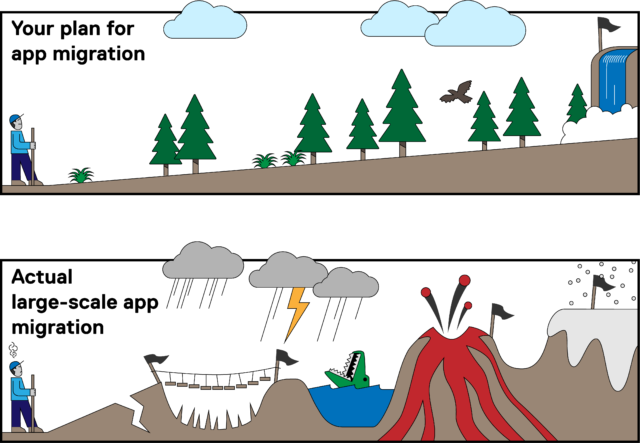When considering whether to migrate workloads from one environment to another, it may seem simple at first. But like moving from one house to another, moving applications is often more complicated than one would expect.
There is a lot to consider when moving to a new house. Cost of the home, space, moving fees, and location are some of the more obvious aspects to think about. But then there are other extraneous, time-consuming activities that can also complicate the moving process, such as visiting and touring potential homes, packing, transporting your belongings, and unpacking all the boxes. All these considerations and more come into play when determining whether to move or stay. Similarly, if you are moving your existing application portfolio to a new environment, it’s important to plan around factors related to time, cost, and business needs. Sure, it might sound appealing to move your workloads at first thought, but there are many calculations that should be done before determining if it’s worth the time and money to do so. Here are some questions to ask yourself before overly investing in an “all in” migration strategy.
What goes into application migration?
Any migration of applications requires time, effort, and resources. But it’s important to first do the math on how much of each are required. By multiplying how many applications need to be moved by the number of hours it would take to prepare each one, you can figure out the total time it would take your organization to move the applications. Dividing that time by the resources you have, you may realize that this is not as cost-effective or productive as it initially seemed. It may also open your eyes to what actions may be necessary in order to meet your deadline – e.g. hiring more developers. It’s not always easy to predict the timing or exact resources required for large-scale application migration, but this thought process will help you to better understand if you can meet your deadline and budget. For one application, your decision might not make such a huge impact. But when you are working with tens, hundreds, or thousands of applications, it will.
What are my options?
The good news is that you have many. You may choose to simply modernize the underlying infrastructure on which the application is kept, retain the application when there is not enough value in moving it, repurchase it as SaaS, or retire it. However, not all applications can “lift and shift” into their new environment, so each application needs to be evaluated individually. Re-platforming and refactoring require modifications to the applications themselves in order to support them running in a new environment. This may entail actions such as containerizing the applications, by breaking them down into microservices, to utilize cloud capabilities. There are many options to consider, and what’s right for one application may not be right for others.
How can I choose an effective strategy for my organization?
It’s important to remember that application migration is a large undertaking. You may hear about organizations that take on substantial migration projects that end up taking years to complete. And there is an opportunity cost associated with the decision. The hours spent updating applications are hours that can’t go into innovation efforts, such as application development and testing.
After you take into consideration time and cost factors, and which options are available, you can determine which strategy will best fit your business and application needs. Not every option will require the same amount of effort and resources to undertake. The moral of the story is: don’t move an application if the migration doesn’t bring more value to your organization. Put in the time to do the math and figure out the right move for each application individually, rather than applying the same treatment to all.

